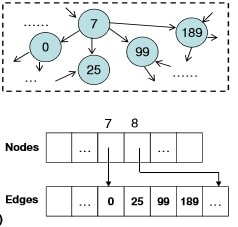Project Installation
- Install cuda by using the link link
- Clone the project
- In the project folder go to src folder
- Compile: nvcc -o a.out bfs.cu
- Run: ./a.out
Implementing Breadth First Search in CUDA
Graph algorithms are a very common requirement in several problem domains including several scientific and engineering applications, and they mostly involve processing large graphs having millions of vertices. In this post I’ll describe an implementation of a popular Graph Algorithm (BFS) on the GPU using CUDA.
Bfs intro and implementation
Breadth First Search is a well known Graph Traversal Algorithm which makes use of a queue as its main data structure. In this approach we should traverse from a selected node (source or starting node) and traverse the graph in the form of layers implying we need to keep exploring the neighboring nodes to the currently processed node. A direct implementation of the traditional BFS algorithm on the GPU may not be possible, since CUDA has a restrictive programming model and is tricky to use as well.
Instead of the traditional implementation of the BFS algorithm using a queue and Adjacency Matrix/List as graph representations, I’ve implemented a variation of the BFS Algorithm as proposed by P Harish and PJ Narayan in their paper Accelerating large graph algorithms on the GPU using CUDA.
In their paper, they present a different data structure to represent graphs in what is called a compact adjacency list form. In this structure, vertices of the graph are present in the array Va. Another array Ea of adjacency lists stores the edge vertices for all the vertices in the graph, such that each entry in the Vertex Array Va refers to the starting index of its adjacent neighboring vertices in Ea (Each entry of Ea refers to a vertex in the vertex array Va ).
Refer to the below picture for clarity:

Algorithm

